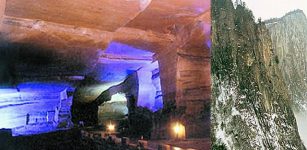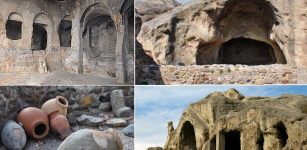Kudurru Of Melishihu – Stone Records From The Kassite Dynasty In Babylonia
A. Sutherland – MessageToEagle.com – “Do not move an ancient boundary stone set up by your forefathers,” says the Bible book of Proverbs 22:28.
Boundary markers for property are a very old concept and the Babylonians had the so-called ‘kudurrus’, stone steles that were sculpted and carved with inscriptions . They were important not only for economic and religious reasons but also as almost the only works of art, which survived from the period of Kassite rule in Babylonia (c. 16th-c. 12th century BC).
A stone document called kudurru (Akkadian: “frontier,” or “boundary”), was inscribed with records of land grants and gifts made by various kings of the Kassite dynasty.
The Kassites first appeared during the reign of Samsu-iluna (1749–1712 BC), son of Hammurabi of the First Babylonian Dynasty and after being defeated by Babylon, moved to control the city-state of Mari.

Some kudurrus are kept in the Louvre in Paris and others in the National Museum of Iraq.
One of them is Kudurru of Melishihu relief made of gray limestone (H 0.65 m; W 0.30 m) and displayed at the Louvre, Paris, but it was brought from Babylonia to Susa Kassite Period (1202-1188 BC).
This kudurru is from the reign of King Melišipak (or alternatively Melišiḫu, who was the 33rd king of the Kassite or 3rd Dynasty of Babylon ca. 1186-1172 BC and he ruled for 15 years. The stone records a land grant to Marduk-apla-iddina, who was his son or successor
It is worth noting that Meli means servant or slave, Šipak was a moon god, but Šiḫu was possibly one of the Kassite names for Marduk, patron God of Babylon.
On the front of the Kudurru, there is a depiction of the entire pantheon of gods who preserve the order of the world.
The artist has used a formula that was later to be developed on other kudurrus, presenting the symbols associated with each deity in hierarchical rows.

These lists of donations were placed under the protection of the greatest possible number of gods, most often represented in their symbolic form and arranged according to the hierarchy of the pantheon.
However, at the top, are symbols of the three heavenly gods; Sin (moon), Shamash (sun) and Ishtar (Venus), in order of their position in the heavens, rather than their importance.
They were surpassed by the supreme triad:
Anu (sky), Enlil (air) symbolized by their horned crowns and Ea (fresh water from the abyss), symbolized by a kind of sceptre carried by a goat-fish.
See also:
Ancient Fascinating City Of Susa That Appeared In The Earliest Sumerian Records
Shamash: Mesopotamian God Of Sun, Truth, Justice And Healing
Code Of Babylonian King Hammurabi
Below we find the emblems of several other gods; that of Marduk, patron-god of Babylon, is identifiable as a pointed hoe placed on a stand and the serpent-dragon which guards the underworld of the god.
The same dragon carries the scribe’s stylet, which is the emblem of Nabu, Marduk’s son. These emblems were difficult to interpret, even for the ancients who sometimes inscribed the name of the gods symbolized next to the symbols themselves.
On the other side of the artifact, there is cuneiform writing describing the gift and the responsibilities to the king as a result of the gift. This is followed by a section calling down a divine curse on anyone who opposed the gift.
Thus, the gift was not only recorded and displayed for all to see, but also placed under divine protection.
The original kudurrus were precious in Babylon and therefore, kept in temples where they would be visible to both worshippers and gods, while their clay replicas were given to the landowners to be placed on the land.
Written by – A. Sutherland – MessageToEagle.com Senior Staff Writer
Copyright © MessageToeagle.com All rights reserved. This material may not be published, broadcast, rewritten or redistributed in whole or part without the express written permission of MessageToeagle.com
Expand for referencesRelated Posts
-
 Ancient Books, Scrolls And Manuscripts Burned By Church And Evil Emperors
No Comments | Feb 6, 2015
Ancient Books, Scrolls And Manuscripts Burned By Church And Evil Emperors
No Comments | Feb 6, 2015 -
 Unanswered Questions Related To The Mysterious Huashan Caves
No Comments | Feb 10, 2015
Unanswered Questions Related To The Mysterious Huashan Caves
No Comments | Feb 10, 2015 -
 Average Brain Has Up To 50,000 Daily Thoughts And 70% Of Them Are Negative
No Comments | Jan 27, 2016
Average Brain Has Up To 50,000 Daily Thoughts And 70% Of Them Are Negative
No Comments | Jan 27, 2016 -
 Prehistoric Hi-Tech Nanospirals Barely Visible To The Naked Eye: Still Remain An Unsolved Mystery
No Comments | Mar 4, 2014
Prehistoric Hi-Tech Nanospirals Barely Visible To The Naked Eye: Still Remain An Unsolved Mystery
No Comments | Mar 4, 2014 -
 Kushite Empire And The Nubian Dynasty – New Research Of Polish Archaeologists
No Comments | Nov 4, 2015
Kushite Empire And The Nubian Dynasty – New Research Of Polish Archaeologists
No Comments | Nov 4, 2015 -
 Towering Sacred Mt. Fuji: Abode Of The Immortals In Ancient Japanese Beliefs
No Comments | Feb 23, 2017
Towering Sacred Mt. Fuji: Abode Of The Immortals In Ancient Japanese Beliefs
No Comments | Feb 23, 2017 -
 Uplistsikhe Devastated By Genghis-Khan Hordes But Once City-Fortress Of Queen Tamar
No Comments | Apr 12, 2021
Uplistsikhe Devastated By Genghis-Khan Hordes But Once City-Fortress Of Queen Tamar
No Comments | Apr 12, 2021 -
 Tamil Brahmi Script Discovered On Ancient Jars In Egypt And Oman
No Comments | Sep 23, 2014
Tamil Brahmi Script Discovered On Ancient Jars In Egypt And Oman
No Comments | Sep 23, 2014 -
 Mystery Of Monte Albán – Ancient City ‘At The Foot Of The Heavens’ Built By The Zapotecs
No Comments | Apr 22, 2016
Mystery Of Monte Albán – Ancient City ‘At The Foot Of The Heavens’ Built By The Zapotecs
No Comments | Apr 22, 2016 -
 Roman Mosaic Dated To Between 60 BC And 300 AD Unearthed In Baalbek
No Comments | Dec 30, 2020
Roman Mosaic Dated To Between 60 BC And 300 AD Unearthed In Baalbek
No Comments | Dec 30, 2020

